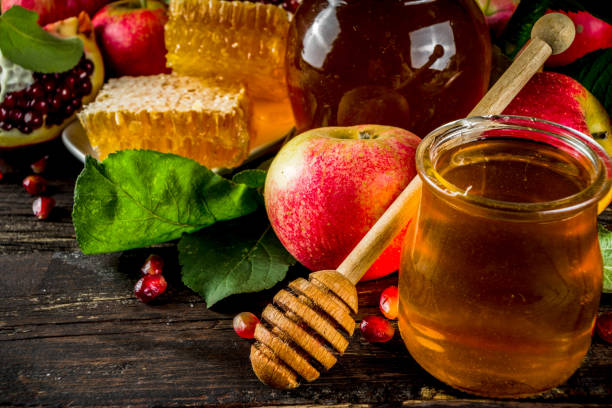קִידוּשׁ לְרֹאשׁ הַשָׁנָה
Hold a cup of wine and recite the Kiddush:
וּבְי֨וֹם שִׂמְחַתְכֶ֥ם וּֽבְמוֹעֲדֵיכֶם֘ וּבְרָאשֵׁ֣י חָדְשֵׁיכֶם֒ וּתְקַעְתֶּ֣ם בַּחֲצֹֽצְרֹ֗ת עַ֚ל עֹ֣לֹתֵיכֶ֔ם וְעַ֖ל זִבְחֵ֣י שַׁלְמֵיכֶ֑ם וְהָי֨וּ לָכֶ֤ם לְזִכָּרוֹן֙ לִפְנֵ֣י אֱלֹֽהֵיכֶ֔ם אֲנִ֖י יְיָ אֱלֹהֵיכֶֽם:
On your festive days and on the new month, you shall sound the horn as you bring your offerings, so it will bring up your memory in front of God.
סָבְרֵי מָרָנָן
With your permission…
בָּרוּךְ אָתָּה יְיָ אֱלֹהֵינוּ מֶּלֶךְ הָעוֹלָם בּוֹרֵא פְרִי הַגֶּפֶן.
You are the source of blessings, God. We thank you for the fruit of the vine.
בָּרוּךְ אָתָּה יְיָ אֱלֹהֵינוּ מֶּלֶךְ הָעוֹלָם אֲשֶׁר בָּחַר בָּנוּ מִכָּל עָם וְרוֹמְמָנוּ מִכָּל לָשׁוֹן וְקִדְּשָׁנוּ בְמִצְוֹתָיו, וַתִּתֶּן לָנוּ יְיָ אֱלֹהֵינוּ בְּאַהֲבָה אֶת יוֹם הַזִּכָּרוֹן הַזֶּה, אֶת יוֹם טוֹב מִקְרָא קוֹדֶשׁ הַזֶּה, יוֹם תְּרוּעָה מִקְרָא קוֹדֶשׁ זֵכֶר לִיצִיאַת מִצְרָיִם, וּדְבָרְךָ מַלְכֵּנוּ אֱמֶת וְקַיָּם לָעַד, בָּרוּךְ אָתָּה יְיָ, מֶלֶךְ עַל כָּל הָאָרֶץ, מְקַדֵּשׁ יִשְׂרָאֵל וְיוֹם הַזִּכָּרוֹן.
You are the source of blessings, God. You have chosen to give us the Torah and elevate us spiritually, through learning and observance. You gave us with love this day, a day of Holy encounter with You, a day of blowing the Shofar and remembering our past. We thank You God for sanctifying us with this day.
סֵדֶר רֹאשׁ הַשָּׁנָה
After the Kiddush, prayers are recited over several foods, which can be eaten or just looked at. The names of these foods serve as a visual reminder for things we want to pray for. All of the symbolic meanings are based on the Hebrew or Aramaic languages, so you can be creative and add elements with symbolism in English (further explanation on pp. 3-4).
תְּמָרִים: (בָּרוּךְ אַתָּה ה’ אֱלוֹקֵינוּ מֶלֶךְ הָעוֹלָם בּוֹרֵא פְּרִי הָעֵץ) יְהִי רָצוֹן מִלְּפָנֶיךָ ה’ אֱלוֹקֵינוּ וֵאלוֹקֵי אֲבוֹתֵינוּ שֶׁיִּתַּמּוּ אוֹיְבֵינוּ וְשׂוֹנְאֵינוּ וְכֹל מְבַקְשֵׁי רָעָתֵנוּ.
Dates (reflecting the verb “to end” in Hebrew): May there will be an end to all our troubles.
רוּבְּיָא – לוּבְּיָא: יְהִי רָצוֹן מִלְּפָנֶיךָ ה’ אֱלוֹקֵינוּ וֵאלוֹקֵי אֲבוֹתֵינוּ שֶׁיִּרְבּוּ זְכֻיּוֹתֵינוּ וּתְלַבְּבֵנוּ.
Black-eyed Peas, or Anise, or Sesame seeds (reflecting the verb “to multiply” and the noun “heart” in Hebrew): May our merits multiply and may God will keep us close to His heart.
כַּרְתֵּי: יְהִי רָצוֹן מִלְּפָנֶיךָ ה’ אֱלוֹקֵינוּ וֵאלוֹקֵי אֲבוֹתֵינוּ שֶׁיִּכָּרְתוּ אוֹיְבֵינוּ וְשׂוֹנְאֵינוּ וְכֹל מְבַקְשֵׁי רָעָתֵנוּ.
Leek or carrots (reflecting the verb “to cut off” in Hebrew): May all who plot evil and destruction be cut off.
סֶלֶק: יְהִי רָצוֹן מִלְּפָנֶיךָ ה’ אֱלוֹקֵינוּ וֵאלוֹקֵי אֲבוֹתֵינוּ שֶׁיִּסְתַּלְּקוּ אוֹיְבֵינוּ וְשׂוֹנְאֵינוּ וְכֹל מְבַקְשֵׁי רָעָתֵנוּ.
Chards or Beets (reflecting the verb “to drive away” in Hebrew): May it be Your will that all our enemies and adversaries will be driven away.
קָרְעָא – דְּלַעַת: יְהִי רָצוֹן מִלְּפָנֶיךָ ה’ אֱלוֹקֵינוּ וֵאלוֹקֵי אֲבוֹתֵינוּ שֶׁתִקְרַע רוֹעַ גְּזַר דִּינֵנוּ וְיִקָּרְאוּ לְפָנֶיךָ זְכֻיּוֹתֵינוּ.
Squash or pumpkin (reflecting the verbs “to read” and “to tear” in Hebrew): May God tear any negative verdicts against us, and may our merits be read in front of Him.
רִמּוֹן: יְהִי רָצוֹן מִלְּפָנֶיךָ ה’ אֱלוֹקֵינוּ וֵאלוֹקֵי אֲבוֹתֵינוּ שֶׁנִּהְיֶה מְלֵאִים מִצְווֹת כַּרִמּוֹן.
Pomegranate: May we be full of Mitzvoth as pomegranates are full of seeds.
תַּפּוּחַ בִּדְבָשׁ: יְהִי רָצוֹן מִלְּפָנֶיךָ ה’ אֱלוֹקֵינוּ וֵאלוֹקֵי אֲבוֹתֵינוּ שֶׁתִּתְחַדֵּשׁ עָלֵינוּ שָׁנָה טוֹבָה וּמְתוּקָה מֵרֵאשִׁית הַשָׁנָה עַד אַחֲרִית הַשָׁנָה.
Apple in Honey: May we have a good and sweet new year, from beginning to end.
רֹאשׁ: יְהִי רָצוֹן מִלְּפָנֶיךָ ה’ אֱלוֹקֵינוּ וֵאלוֹקֵי אֲבוֹתֵינוּ שֶׁנִּהְיֶה לְרֹאשׁ וְלֹא לְזָנָב.
Head: May we lead others to do good and not follow wrongdoings of others.
Rosh Hashana Seder and Simanim
Medjool dates, apple in honey, black-eyed peas, sesame seeds, spinach, squash, and pomegranate seeds may be on our menu this coming Monday, as we sit for the first meal of the Hebrew New Year.
As exciting and wonderful as the Rosh HaShana Seder, as some call it, is, there are some questions and dilemmas surrounding it:
- What is the exact order of the Simanim (signs)?
- Do we eat the Simanim before or after the meal?
- What if some people (read: the children) do not want to eat the spinach?
- Should vegans, who would not eat the head of a lamb or a fish, eat a head of garlic cloves instead?
- Which Simanim are included in the list?
- And most importantly: doesn’t the whole obsession with signs on Rosh HaShana border on paganism or superstitions?
Let us dwell on this last one. Because of the belief that eating sweet things will lead to a sweet year, there are those who avoid eating spicy, sour, bitter, or dark-colored foods. Some foods are excluded from one community’s list, but are mandatory for another (almonds, for example). How can we understand a practice which ties the events of the year with the foods eaten at the beginning of the year? And what if a person is bed-ridden and only had liquids and medicine on Rosh HaShana? Will his year be liquidy? Advily?
To answer all these questions, and to get a better understanding of the term Siman, which many translate as omen, let us turn to the source of the practice in the Talmud.[1] It appears after several perplexing suggestions for predicting the future. The first experiment informs a person whether he will survive or not until the following Rosh HaShana. In order to discover this terrifying piece of information, one should light a candle in a house where there is not even the slightest draft. If the candle flame is unwavering, he can rest assured, but if it flickers, he’d better call the funeral home.
The next one deals with one who wants to start a business and would like to know if he will be successful. He is advised to buy a rooster and feed it. If the rooster becomes fatter, the novice farmer is guaranteed stellar success in his financial endeavors. If, however, the rooster remains slim waisted, our budding entrepreneur should consider visiting the employment agency. There is one more suggestion which the Talmud rejects, and then we hear the following statement from the Talmudic sage Abayye (הוריות, יב:א): Now that you say that Siman has significance, one should try to see on Rosh HaShana squash, black-eyed peas, leeks, spinach, and dates.
I understand this Talmudic paragraph as a response to the widespread phenomenon of reliance on astrology and incantations in Babylonia. The rabbis wanted to teach people that the most accurate indicator of one’s future is his own behavior. Accordingly, in the first case we deal with someone who wants to know whether or not he will survive the year. He is told to light a candle in a draft-less home and make sure that the flame does not flicker. Oh, but it does. The terrified man scurries from wall to wall, from crevice to crevice, with plaster and a spatula but alas, for every hole he discovers, breeze comes in from ten others. If our man is somewhat wise he will stop after a while, realizing that the experiment was a sign for him. You can never cover all holes and you never know what incredible things will happen this coming year, for good or bad. At that point one starts directing his efforts during the year towards responsibility and awareness, visualizing gaps he must bridge in order to protect his flame, thus (hopefully) prolonging his life.
In the second experiment, one is required to fatten a rooster in order to predict whether he will have success in business. Once he brings the rooster home, he understands that in order to grow it fat he has to pay constant attention. He must protect the bird from diseases and predators, provide food, water and shelter, clean after it, and rise at dawn (or at midnight) with its call. He now also understands how to succeed in business. He must work hard, pay attention to details, and be willing to accept difficulties and small failures before emerging victorious.
In reaction to these two very practical thought experiments, Abayye says that now we know that associating our aspirations and hopes with a visual image or object is a helpful technique. He therefore says that one should see on Rosh HaShana certain species, so the image will help him focus his thoughts during prayers. In other words, it is not seeing or eating the honeyed apple or the dates which guarantees a sweet year, but the constant image of these fruits which drives a person in the prayers and throughout the year. It is very similar to soldiers carrying the pictures of their loved ones in a locket so they will be inspired to survive at all costs.
Conclusion:
The practice of Simanim should be translated not as omens but rather as suggestive visual meditation. In the original phrasing of the practice the idea was to see, not eat, the fruits. One can therefore choose to eat or not eat any of the Simanim. The order is insignificant but it is best for all participants to follow one version to avoid conflicts. It is also a good idea to add some foods which could be easily associated with the spoken language, since the Simanim have meaning only in Hebrew.
If you are not eating meat you could have some candies (actually, even if you eat meat you could just look at the wrappers) which could have positive associations for English speakers such as: 5th Avenue, Skor, PayDay, Life Savers. Top it off with a Brach’s candy (for Bracha), and most importantly, make sure that everyone feels happy, relaxed, and welcomed at this Rosh HaShana Seder.
Shana Tova uMetuka








Ohr HaChaim Yomi – Emor